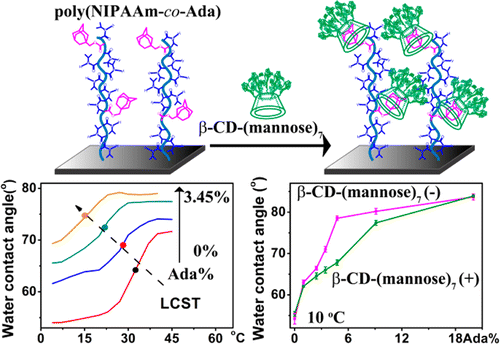Control the Wettability of Poly(N-isopropylacrylamide-co-1-adamantan-1-ylmethyl acrylate) Modified Surfaces: The More Ada, the Bigger Impact?
Xiu-Juan Shi †, Gao-Jian Chen *†‡(陈高健), Yan-Wei Wang †, Lin Yuan †, Qiang Zhang §, David M. Haddleton §, and Hong Chen *†(陈红)
† College of Chemistry, Chemical Engineering and Materials Science, Soochow University, Suzhou 215123, P. R. China
‡ Center for Soft Condensed Matter Physics and Interdisciplinary Research, Soochow University, Suzhou 215006, P. R. China
§ Department of Chemistry, University of Warwick, Coventry CV4 7AL, U.K.
Langmuir 2013, 29, 14188–14195
Surface-initiated SET-LRP was used to synthesize polymer brush containing N-isopropylacrylamide and adamantyl acrylate using Cu(I)Cl/Me6-TREN as precursor catalyst and isopropanol/H2O as solvent. Different reaction conditions were explored to investigate the influence of different parameters (reaction time, catalyst concentration, monomer concentration) on the polymerization. Copolymers with variable 1-adamantan-1-ylmethyl acrylate (Ada) content and comparable thickness were synthesized onto silicon surfaces. Furthermore, the hydrophilic and bioactive molecule β-cyclodextrin-(mannose)7 (CDm) was synthesized and complexed with adamantane via host–guest interaction. The effect of adamantane alone and the effect of CDm together with adamantane on the wettability and thermoresponsive property of surface were investigated in detail. Experimental and molecular structure analysis showed that Ada at certain content together with CDm has the greatest impact on surface wettability. When Ada content was high (20%), copolymer–CDm surfaces showed almost no CDm complexed with Ada as the result of steric hindrance.

链接: //pubs.acs.org/doi/abs/10.1021/la4037748
